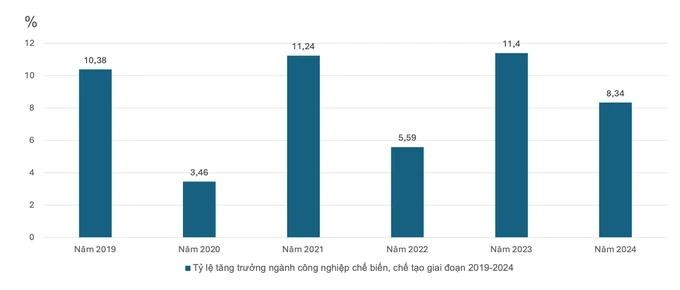Government's Investment Stimulus: Good intentions, bad implementation
Over VND1.5 trillion (about US$59 million) has been allocated to support businesses in revitalizing their production capacity and enhancing their position in Ho Chi Minh City's global supply chain but businesses are starving for funds.

Slow procedures have hindered disbursement, leaving some businesses unable to access the funds. As a result, several companies have been forced to submit petitions to city leaders due to depleted production capital.
Insufficient capital hinders business growth
Chairman Do Phuoc Tong of the Ho Chi Minh City Electromechanical Association highlighted that supporting industry enterprises have long been characterized by a "thirst for capital" and a tendency to "stay small" which has contributed to their lack of growth for over 30 years.
To integrate products into the global supply chain, companies must invest in completing their manufacturing plants, ensuring that the product is competitively priced and meets global standards. To achieve this, they need to secure investment capital, as their own funds are insufficient. However, for many years, the burden of borrowing at high interest rates has been a constant challenge for many companies.
The supporting industry is characterized by substantial investment requirements and extended payback durations, primarily due to its limited profit margins. Additionally, the market for this category of products is relatively restricted, concentrating on specialized supply chains. Consequently, it is imperative for governments to implement targeted capital support policies, offering significantly low interest rates, enabling businesses to secure funding at an average interest rate of merely 2 percent per annum.
In reality, Vietnamese enterprises face high commercial interest rates, ranging from 8 percent-12 percent annually. When the financial market fluctuates, these rates can spike above 16 percent. This makes it difficult for enterprises to produce goods at competitive prices, resulting in unstable industry growth over the years.
Deputy General Director Nguyen Quang Thanh of Ho Chi Minh City State Financial Investment Company (HFIC), stated that to address the challenges faced by businesses and promote the robust growth of the supporting technology industry, the municipal People's Committee has introduced a breakthrough policy through Resolution 98, which includes the Investment Stimulus Program. This year, the city has allocated VND1,500 billion for the program.
Under this initiative, businesses in the supporting industry can borrow up to VND200 billion per project, with interest rates potentially subsidized by 50 percent to 100 percent.
The stimulus policy was initially met with enthusiasm from enterprises, who viewed it as a timely and innovative measure that would drive business development. However, despite the policy being issued in July, Ho Chi Minh City has yet to see any projects access the available loan capital. HFIC said that because the operating regulations of the appraisal team under the Department of Planning and Investment and the Department of Industry and Trade have not been issued, the program has been frozen.
Government should work more to quickly remove bottleneck
By 2024, Vietnam's supporting industry sector is projected to have around 5,000 enterprises, comprising approximately 4.5 percent of the country's total processing and manufacturing enterprises. Notably, the supporting industry sector in Ho Chi Minh City alone is expected to host roughly 1,500 enterprises.
Notwithstanding, domestic enterprises continue to grapple with scaling and capacity limitations. A significant proportion of supporting industry firms are characterized by small-scale operations and outdated technologies, rendering them incompatible with the exacting demands of multinational corporations. Domestic production is largely confined to low-value-added, simple components.

Moreover, tenuous supply chain connections, especially the tenuous link between domestic and foreign direct investment enterprises, impede substantial participation in global value chains.
Takeo Nakajima, JETRO's Chief Representative in Vietnam revealed that in comparison with China, Thailand, India, and Indonesia, the number of Vietnamese supporting industry enterprises deeply participating in the global supply chain is still low. This proves that Vietnamese supporting industry products are still simple, and do not have many multi-detail products and core products.
According to economic experts, in order to promote the development of the supporting industry, there should be synchronous policies such as: timely capital injection; improving product quality and expanding markets for enterprises in the industry; providing tax, credit and land incentives; simplifying administrative procedures to create a favorable business environment.
Deputy Director Le Nguyen Duy Oanh of the Ho Chi Minh City Supporting Industry Development Center emphasized that the coordinated implementation of solutions will enable the sustainable development of Vietnam's supporting industry, enhance its competitiveness, and make a positive contribution to the country's industrialization and modernization process.
Concurrently, observing global economic trends, the World Bank (WB) has offered pragmatic recommendations to the Southeast Asian country. The WB's recent report named "Vietnam 2045: Enhancing trade position in a changing world - the path to a high-income future" underscores Vietnam's status as one of the world's most open economies, with approximately 50 percent of GDP and employment directly or indirectly tied to exports. Thus, the cultivation of supporting industries will establish a resilient bedrock for the domestic economy.
Plus, Vietnam needs to pursue key policy solutions including promoting in-depth trade integration; strengthening the connection between domestic enterprises and global value chains; promoting high-tech activities; transitioning to a low-carbon production model, adapting to climate change, said WB Regional Vice President for East Asia and Pacific (EAP) Manuela V. Ferro.








